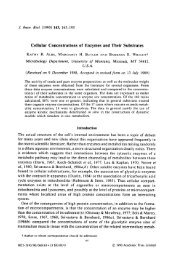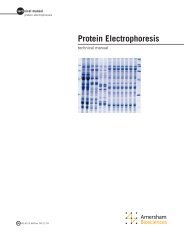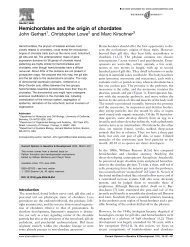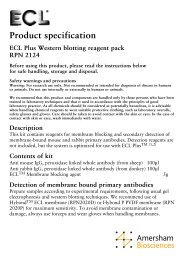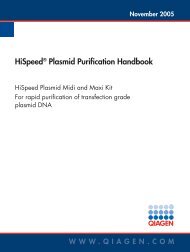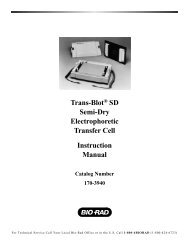Invitrogen Bac to Bac Expression System
Invitrogen Bac to Bac Expression System
Invitrogen Bac to Bac Expression System
Create successful ePaper yourself
Turn your PDF publications into a flip-book with our unique Google optimized e-Paper software.
Isolating P1 Viral S<strong>to</strong>ck<br />
Introduction<br />
Budded virus should be released in<strong>to</strong> the medium 72 hours after transfection.<br />
However, if your transfection efficiency was not optimal, cells may not show all<br />
of the signs of viral infection until 4 or 5 days post-transfection. Beginning at<br />
72 hours after transfection, you should visually inspect the cells daily for signs of<br />
infection (see below). Once the cells appear infected (i.e. demonstrate<br />
chacteristics typical of late <strong>to</strong> very late infection), harvest the virus from the cell<br />
culture medium using the procedure below.<br />
Characteristics of<br />
Infected Cells<br />
Virally-infected insect cells typically display the following characteristics as<br />
observed from visual inspection using an inverted phase microscope at 250-400X<br />
magnification. The time points provided below assume that the transfection was<br />
successful (i.e. transfection efficiency was high).<br />
Signs of Infection Phenotype Description<br />
Early (first 24 hours)<br />
Late (24-72 hours)<br />
Increased cell diameter<br />
Increased size of cell nuclei<br />
Cessation of cell growth<br />
A 25-50% increase in cell diameter may be seen.<br />
Nuclei may appear <strong>to</strong> "fill" the cells.<br />
Cells appear <strong>to</strong> s<strong>to</strong>p growing when compared <strong>to</strong><br />
a cell-only control.<br />
Granular appearance Signs of viral budding; vesicular appearance <strong>to</strong><br />
cells.<br />
Detachment<br />
Cells release from the plate or flask.<br />
Very Late (>72 hours) Cell lysis Cells appear lysed, and show signs of clearing in<br />
the monolayer.<br />
Preparing the P1<br />
Viral S<strong>to</strong>ck<br />
1. Once the transfected cells from Step 8, previous page demonstrate signs of late<br />
stage infection (e.g. 72 hours post-transfection), collect the medium containing<br />
virus from each well (~2 ml) and transfer <strong>to</strong> sterile 15 ml snap-cap tubes.<br />
Centrifuge the tubes at 500 x g for 5 minutes <strong>to</strong> remove cells and large debris.<br />
2. Transfer the clarified supernatant <strong>to</strong> fresh 15 ml snap-cap tubes. This is the P1<br />
viral s<strong>to</strong>ck. S<strong>to</strong>re at +4ºC, protected from light. See the next page for additional<br />
s<strong>to</strong>rage information.<br />
Note: If you wish <strong>to</strong> concentrate your viral s<strong>to</strong>ck <strong>to</strong> obtain a higher titer, you<br />
may filter your viral supernatant through a 0.2 µm, low protein binding filter<br />
after the low-speed centrifugation step, if desired.<br />
continued on next page<br />
29



